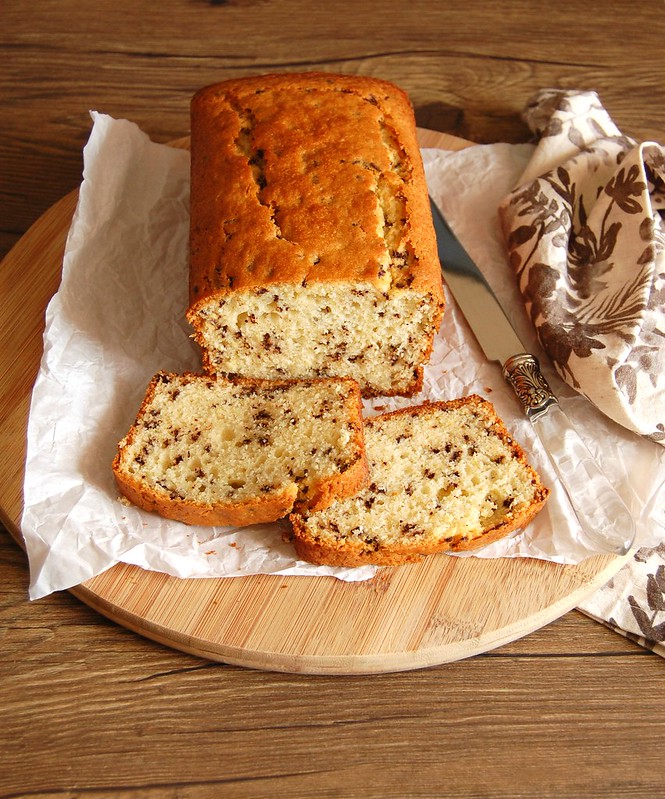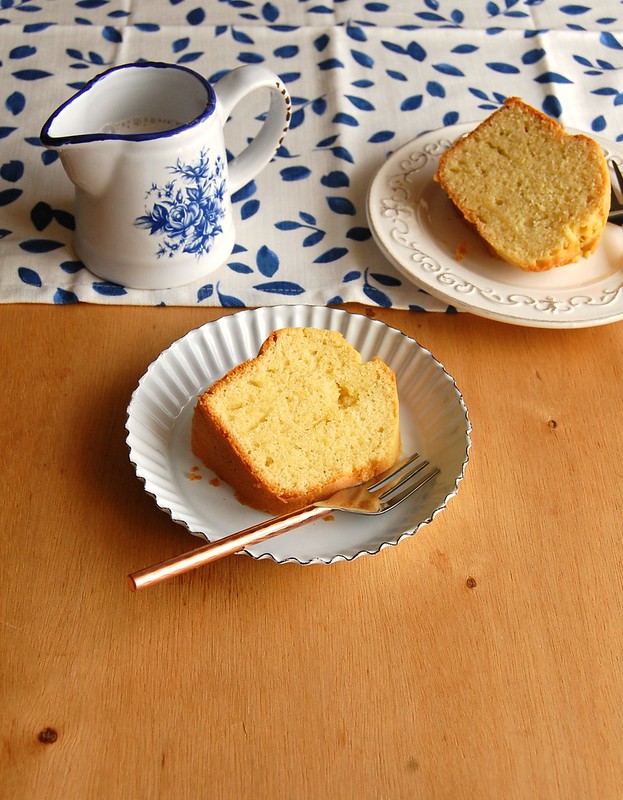Those of you who follow the news about Brazil probably know that the situation here is completely chaotic: not only we have to deal with a virus, we also have to deal with a psychopath in the presidency of the country. It has not been easy to keep sane.
I have found solace in the kitchen, cooking and baking, trying to make my days a little bit lighter and happier. I made this cake last week, using again the Epicurious’ yogurt cake as base and it turned out amazing: super tender, perfumed with orange, delicious. I added chocolate sprinkles in order to turn the cake into an anthill cake, a popular cake in Brazil.
I hope you like the recipe much as I did.
Anthill orange yogurt cake
slightly adapted from Epicurious
1 ½ cups (210g) all-purpose flour
2 teaspoons baking powder
¼ teaspoon table salt
1 cup (200g) granulated sugar
finely grated zest of 1 large orange
¾ cup (180g) plain yogurt – I used sheep’s milk yogurt
½ cup (120ml) vegetable oil – I used canola
2 large eggs, room temperature
1 teaspoon vanilla extract
3 tablespoons chocolate sprinkles
Preheat oven to 180C/350°F. Lightly brush a 6-cup capacity loaf pan with oil, line it with baking paper and then brush the paper as well.
In a medium bowl, whisk together the flour, baking powder and salt. Set aside.
In a large bowl, whisk together the sugar and orange zest and rub together with your fingertips until sugar is fragrant. Add yogurt, oil, eggs and vanilla and whisk until smooth. Fold in reserved dry ingredients, keeping 1 tablespoon reserved, just to blend – if batter is too lumpy, whisk for a few seconds. Stir the chocolate sprinkles into the reserved flour mixture, then fold everything into the batter.
Pour the batter into prepared pan and smooth the top. Bake for 50-55 minutes, or until a skewer or toothpick inserted into center of the cake comes out clean.
Let cake cool in pan on a wire rack for 15 minutes. Carefully and using the paper as a guide, remove cake from pan and transfer to the rack to cool completely.
The cake can be stored in an airtight container at room temperature for up to 3 days.
Serves 8
Monday, June 22, 2020
Anthill orange yogurt cake
Thursday, June 11, 2020
Ratatouille calzones
Last week I told Joao that for the weekend I wanted to make something different for lunch: I was not in the mood for pasta or for the good old rice and beans combo, and I definitely wanted to try my hands at a new recipe.
Going through the vegetables in my fridge I found one eggplant, one zucchini, a couple of carrots and that was it: not much to choose from. So I kept the carrots for some other time and used the eggplant and the zucchini to make a sort of ratatouille, adding tomato paste and olive to make the mixture more interesting. Mixed with cheese it became the filling for these calzones and I bring you this recipe with a very proud smile: the calzones turned out so good!
Apparently going through the crisper drawer might be a good creative exercise. :D
The recipe yields 8 large calzones, which is too much for the both of us for one meal, so I froze the remaining calzones and we ate them for dinner yesterday. If you want to do the same, just wait for the calzones to cool completely, wrap in foil and place them in a plastic bag, sealing well. Once the calzones are thawed, 10 minutes in a hot oven are enough to make them delicious again.
Ratatouille calzones
own recipe
Dough:
2 teaspoons dried yeast
½ teaspoon granulated sugar
1 ¼ cups (300ml) lukewarm water
2 tablespoons extra-virgin olive oil
3 cups (420g) all purpose flour
1 ¼ teaspoons table salt
Filling:
1 ½ tablespoons olive oil
½ small onion, finely diced
1 large garlic clove, minced
1 medium zucchini (240g), in 1cm-cubes
1 medium eggplant (300g), in 1cm-cubes
1 bay leaf
salt and freshly ground black pepper
½ tablespoon tomato paste
1 tablespoon dry white wine
10 large black olives, pitted and finely chopped
1 ½ cups (150g) coarsely grated yellow mozzarella*
3 tablespoons coarsely grated parmesan
2 teaspoons dried oregano
After assembling the calzones:
olive oil, for brushing
finely grated parmesan, for sprinkling over the calzones
Start with the dough: in the bowl of an electric mixer fitted with the dough hook, mix the yeast, sugar and water with a fork. Set aside until foamy, about 5 minutes. Add the olive oil, flour and salt and mix for 6-8 minutes or until a soft and elastic dough forms. Shape dough into a ball and transfer to a lightly oiled bowl. Cover with plastic wrap and set aside to proof in a warm place for about 1 hour or until doubled in size – mine proved for 90 minutes.
In the meantime, make the filling: heat a large nonstick frying pan over medium heat. Add the onion and cook stirring occasionally until tender and translucent. Add the garlic and cook for 1 minute or until fragrant – do not let it burn or it will get bitter. Stir in zucchini, eggplant and bay leaf, season with salt and pepper. Cook for 5-7 minutes or until vegetables are softer. Stir in the tomato paste and cook for 2 minutes – it is important to cook it thoroughly to avoid the raw tomato aftertaste. Add the wine and cook for 1 minute, then stir in the olives. Remove from the heat, cool completely, discard the bay leaf and then stir in the cheeses and the oregano.
Preheat the oven to 420°F/220°C. Have ready two large baking sheets.
Divide the dough into 8 equal parts – each will be around 100g (3 ½ oz.). Roll out each portion of dough on a lightly floured surface until you get a rough 25cm (10in) circle. Place about ½ cup of the filling on one side of the dough and fold the other half over, pinching the seams well to keep the filling inside – since vegetables can vary in size, if you have a scale weigh the filling and divide it equally in 8 portions. Repeat the process with the remaining dough and filling. Place the calzones onto the sheets and brush them with the olive oil and sprinkle with the parmesan. Bake for about 20 minutes or until golden. Serve immediately.
* the yellow mozzarella I used is not like fresh mozzarella balls, therefore it does not release too much liquid. Replace by cheddar or something similar texture wise.
Makes 8
Monday, June 8, 2020
Lime olive oil pound cake
During this isolation period, I have not made too many sweets: my husband is not into them very much and I don’t want to end up eating it all myself. I do search for some chocolate when anxiety comes hard on me, I must confess, but having to deal with an entire cake before it goes stale might be tricky.
So in almost 3 months at home I have baked 3 cakes so far, one being the yogurt marble cake I shared with you weeks ago. I felt like baking another cake last week, but didn’t have time to wait for the butter to soften (and I don’t have a microwave oven to speed up the process). So I made Alice Medrich’s pound cake with olive oil and it was not only easy to put together but it turned out tender and delicious. I could have used sherry, as the original recipe calls for, but I wanted a recipe that more people could make during these times, so I adapted it a little bit and replaced the booze with milk. A little lime zest and a pinch of nutmeg made it all even better.
Lime olive oil pound cake
adapted from the sherry and olive oil pound cake on this book
2 cups (280g) all purpose flour
1 ¼ teaspoons baking powder
1/8 teaspoon freshly ground nutmeg
1/8 teaspoon salt
½ cup + 2 tablespoons (125g) sugar
finely grated zest of 2 limes
150ml flavorful extra virgin olive oil
3 cold eggs
½ teaspoon vanilla extract
150ml whole milk, room temperature
Preheat the oven to 180°C/350°F. Butter and flour an 8-cup capacity Bundt pan.
In a medium bowl, whisk the flour, baking powder, nutmeg and salt. Set aside.
In the bowl of an electric mixer fitted with the whisk attachment, combine sugar and lime zest and rub with your fingertips until sugar is fragrant. Add the oil and beat until well blended. Add the eggs one at a time, beating well after each addition. Continue to beat until the mixture is thick and pale, 3-5 minutes. Beat in the vanilla. Stop the mixer and add 1/3 of the flour mixture. Beat on low speed just until blended. Stop the mixer and add ½ of the milk, then beat just until it is blended. Repeat with another third of the flour, followed by the remaining milk, and then the remaining flour.
Scrape the batter into the pan and smooth the top. Bake until a cake tester comes out clean, about 50 minutes. Cool the cake in the pan on a rack for about 20 minutes. Invert the cake onto the rack and cool completely.
Serves 8-10





